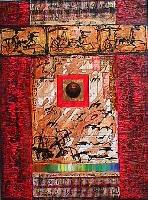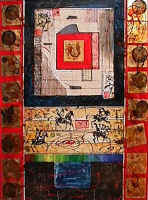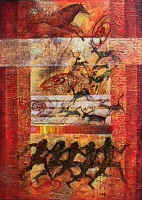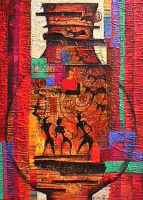|
By
far one of the most exciting developments in recent art is the
continuing confluence of Eastern and Western aesthetics. Finally those
once distant twains that, according to the racist Kipling, were never
supposed to meet, have not only met but merged with a vengeance, and we
are all the richer for it.
One
of the more auspicious examples to prove this point is the work of Mai
Cheng Zheng, a Chinese painter living and working in Oslo, Norway, whose
solo show "Feng-shui Art: Ancient Signs" can be seen from
November 28 through December 17 at Noho Gallery, 168 Mercer Street.
Although
the Chinese have been practicing feng-shui for four thousand years, most
Americans have only become familiar with the term in recent decades.
Feng-shui, which translates from Chinese as "wind and water,"
is the ancient science of arranging the elements of one's life,
particularly one's living and working spaces, to be in accord with
nature. Practitioners of feng-shui claim that the proper positioning of
one's desk or bed can have a profound affect on one's energy, one's
work, and other aspect's of one's life, bringing them into harmony with
nature and increasing not only one's creative efficiency but also one's
sense of well being.
Mai
Cheng Zheng took this longheld belief system a step further when she
began to apply the principles of feng-shui to the art of painting as a
student at Beijing's Central Academy of Arts and Design in the late 70s.
In 1981, however, after seeing an exhibition of works by the Norwegian
expressionist Edvard Munch in the National Gallery in Beijing, she
became enamored of Expressionism. Determined to study in Munch's
homeland, she was accepted at the State Academy of Arts in Oslo, and
later received a post graduate scholarship at the Art Academy in Bergen.
In
true multicultural fashion, the artist who became a Norwegian citizen in
1989, resumed her interest in feng-shui, teaching Norwegians to arrange
their working and living spaces more efficiently. At the same time, as a
-fine artist, she began reintroducing feng-shui principles, along with
more Western elements (such as her preference for oil paint over ink)
into her work as well.
Since,
Mai Cheng Zheng has become internationally known for her auspicious
synthesis of Eastern and Western aesthetics, with exhibitions in such
prestigious venues as the National Gallery in Beijing, where she first
discovered Munch, and Espace Bateau Lavoir in Paris, a gallery that once
represented Picasso. She has also exhibited in Germany, Belgium, and
Iceland, and had solo shows at Galleri Asur in Oslo.
In
her most recent exhibition at Noho Gallery, in Soho, the first thing
that strikes one about Mai Cheng Zheng's work is the balance that she
achieves between contemporary immediacy and timeless beauty. In
paintings at once funky and elegant, her use of fragmentary figurative
imagery and graffiti-like scrawls and signs within largely abstract
color areas can recall no less an enfant terrible of the untrammeled
gesture than the late JeanMichel Basquiat.
Mai
Cheng Zheng, however, employs such devices in a less aggressive and more
deliberate manner, to achieve balance and harmony rather than
dissonance. She accomplishes this by always balancing cold colors with
warmer ones. She also invariably sets up contrasts between forms and
shapes that are small and large, creating a sense of their being near or
far. Thus she brings the principles of yin and yang, or positive and
negative, which are the basis for feng-shui, to bear in her
compositions.
There
is an impulse toward the sumptuous and the exquisite that moors Mai
Cheng Zheng's work not in the monochromatic Literati tradition, from
whose gestural vivacity certain Abstract Expressionists drew
inspiration, but in much earlier 8th century Chinese tomb paintings,
with their combination of delicate linearity, earthy mineral colors, and
tactile fresco surfaces. Her use of vibrant reds, gold hues, and
glistening blacks, in combination with more subdued colors, harks back,
too, to the lacquered opulence of the Tang dynasty.
Then
there are disparate elements in Mai Cheng Zheng's personal semiotics
that refer even further back to prehistoric cave paintings: simplified
bisons, horses, antelopes, and other fanciful beasts, as well as rows of
running human figures laid down in slashing black strokes that in their
staggered urgency suggest the precise instant when images verged on
ideograms, that magical moment of metamorphosis when pictures became
written language. These signs are derived from sources as diverse as her
own Chinese heritage, Nordic runes, and Egyptian hieroglyphics, all of
which she combines to express universal commonalities.
Mai
Cheng Zheng also combines such archetypal signs with more contemporary
elements adopted from expressionism and action painting, such as skeins
and drips ala Pollock, to achieve dynamic juxtapositions of figure,
form, and gesture. Whiplash calligraphic strokes are employed quite
masterfully to animate the surfaces of her paintings in much that same
manner as Cy Twombly's scrawled phrases.
These
calligraphic elements are especially plentiful and energetic in Mai
Cheng Zheng's painting "Silk Road,"
where various staid rectangular forms are juxtaposed with a sinuous and
intricate network of linear shapes that dance in swarming profusion over
a surface further enhanced by partial scrapings revealing the layered
imagery that may be referred to as "aesthetic
archaeology." Here, the interaction between static and fluid
elements is especially dynamic, demonstrating this artist's belief that
"only when two opposite forces are acting together, do we get
energy."
By
contrast, "Inventor of the Wheel"
is a bold composition that juxtaposes superimposed rectangles in
brilliant red and yellow hues with the silhouetted figure of a man, a
wheel, and a rearing animal. In this painting, Mai Cheng Zheng's use of
texture is especially sensual, with striated impastos contributing
considerable tactile appeal to the overall design. An intriguing array
of smaller signs and symbols are scrawled within the rectangle
containing the central figures, and the painting is further enlivened by
four irregularly shaped roundish red forms that float down the right
side of the composition, providing a buoyant contrast to the more
austere geometric shapes.
A
fanciful array of symbols, depicting the graceful flight of various
creatures is the central focus of the painting entitled "The
Riders' Tale." Here, too, the overall composition is
apportioned into rectangular divisions, with two large squares
delineated in brilliant red, gold, and rainbow hues, dominating the
center, and two vertical rows of smaller gold squares bordering both
sides. This is an especially engaging painting, its compartmentalized
composition of interlocking "frames" suggesting an almost
cinematic sequencing, its lively pictographic imagery conveying the
sense of an epic narrative or myth.
In
other paintings such as "The Movement
of History" and "The Jar of
Signs," Mai Cheng Zheng elaborates upon similar themes in
distinctly different ways. The latter painting is an interesting
compositional departure, with the boldly outlined contours of a large
vase surrounding various silhouetted human and animal shapes, suggesting
culture as a container for history, a receptacle for our common human
heritage.
Indeed,
it is precisely her ability to encapsulate archetypes and universal
themes in vital visual terms that makes the art of Mai Cheng Zheng
ultimately valuable and rewarding.
Byron
Coleman | ||||||



